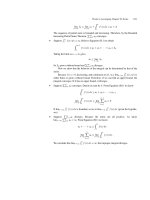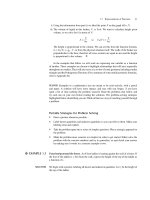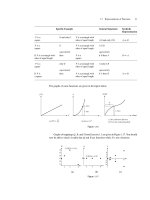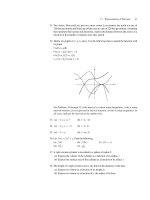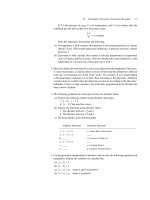Calculus: An Integrated Approach to Functions and their Rates of Change, Preliminary Edition Part 2 ppsx
Bạn đang xem bản rút gọn của tài liệu. Xem và tải ngay bản đầy đủ của tài liệu tại đây (166.59 KB, 10 trang )
Preface xi
course. Sections on algebra, the theoretical basis of calculus, including Rolle’s Theorem
and the Mean Value Theorem, induction, conics, l’H
ˆ
opital’s Rule for using derivatives
to evaluate limits of an indeterminate form, and Newton’s method of using derivatives
to approximate roots constitute Appendices A, C, D, E, F, and G, respectively. Certain
appendices can be transported directly into the course. Others can be used as the basis of
independent student projects.
This book is a preliminary edition and should be viewed as a work in progress. The
exposition and choice and sequencing of topics have evolved over the years and will, I
expect, continue to evolve. I welcome instructors’ and students’ comments and suggestions
on this edition. I can be contacted at the addresses given below.
Robin Gottlieb
Department of Mathematics
1 Oxford Street
Cambridge, MA 02138
Acknowledgments
A work in progress incurs many debts. I truly appreciate the good humor that participants
have shown while working with an evolving course and text. For its progress to this point
I’d like to thank all my students and all my fellow instructors and course assistants for their
feedback, cooperation, help, and enthusiasm. They include Kevin Oden, Eric Brussel, Eric
Towne, Joseph Harris, Andrew Engelward, Esther Silberstein, Ann Ryu, Peter Gilchrist,
Tamara Lefcourt, Luke Hunsberger, Otto Bretscher, Matthew Leerberg, Jason Sunderson,
Jeanie Yoon, Dakota Pippins, Ambrose Huang, and Barbara Damianic. Special thanks to
Eric Towne, without whose help writing course notes in the academic year 1996-1997 this
text would not exist. Special thanks also to Eric Brussel whose support for the project
has been invaluable, and Peter Gilchrist whose help this past summer was instrumental
in getting this preliminary edition ready. Thanks to Matt Leingang and Oliver Knill for
technical assistance, to Janine Clookey and Esther Silberstein for start-up assistance, and
to everyone in the Harvard Mathematics department for enabling me to work on this book
over these past years.
I alsowant to acknowledge the type-setting assistance of Paul Anagnostopoulos, Renata
D’Arcangelo, Daniel Larson, Eleanor Williams, and numerous others. For the art, I’d like
to acknowledge the work of George Nichols, and also of Ben Stephens and Huan Yang.
For their work on solutions, thanks go to Peter Gilchrist, Boris Khentov, Dave Marlow, and
Sean Owen and coworkers.
My thanks to the team at Addison-Wesley for accepting the assortment of materials
they were given and carrying out the Herculean task of turning it into a book, especially to
Laurie Rosatone for her encouragement and confidence in the project and Ellen Keohane
for her assistance and coordination efforts. It has been a special pleasure to work with
Julie LaChance in production; I appreciate her effort and support. Thanks also to Joe
Vetere, Caroline Fell, Karen Guardino, Sara Anderson, Michael Boezi, Susan Laferriere,
and Barbara Atkinson. And thanks to Elka Block and Frank Purcell, for their comments and
suggestions.
Finally, I want to thank the following people who reviewed this preliminary edition:
Dashan Fan, University of Wisconsin, Milwaukee
Baxter Johns, Baylor University
Michael Moses, George Washington University
xii Preface
Peter Philliou, Northeastern University
Carol S. Schumacher, Kenyon College
Eugene Spiegel, The University of Connecticut
Robert Stein, California State University, San Bernardino
James A. Walsh, Oberlin College
To the Student
This text has multiple goals. To begin with, you should learn calculus. Your understanding
should be deep; you ought to feel it in your bones. Your understanding should be portable;
you ought to be able to take it with you and apply it in a variety of contexts. Mathematicians
find mathematics exciting and beautiful, and this book may, I hope, provide you with a
window through which to see, appreciate, and even come to share this excitement.
In some sense mathematics is a language—a way to communicate. You can think of
some of your mathematics work as a language lab. Learning any language requires active
practice; it requires drill; it requires expressing your own thoughts in that language. But
mathematics is more than simply a language. Mathematics is born from inquiry. New
mathematics arises from problem solving and from pushing out the boundaries of what is
known. Questioning leads to the expansion of knowledge; it is the heart of academic pursuit.
From one question springs a host of other questions. Like a branching road, a single inquiry
can lead down multiple paths. A path may meander, may lead to a dead-end, detour into
fascinating terrain, or steer a straight course toward your destination. The art of questioning,
coupled with some good, all-purpose problem-solving skills, may be more important than
any neatly packaged set of facts you have tucked under your arm as you stroll away from
your studies at the end of the year. For this reason, the text is not a crisp, neatly packed
and ironed set of facts. But because you will want to carry away something you can use for
reference in the future, this book will supply some concise summaries of the conclusions
reached as a result of the investigations in it.
We, the author and your instructors, would like you to leave the course equipped with
a toolbox of problem-solving skills and strategies—skills and strategies that you have tried
and tested throughout the year. We encourage you to break down the complex problems you
tackle into a sequence of simpler pieces that can be put together to construct a solution. We
urge you to try out your solutions in simple concrete cases and to use numerical, graphical,
and analytic methods to investigate problems. We ask that you think about the answers you
get, compare them with what you expect, and decide whether your answers are reasonable.
Many students will use the mathematics learned in this text in the context of another
discipline: biology, medicine, environmental science, physics, chemistry, economics, or
one of the social sciences. Therefore, the text offers quite a bit of mathematical modeling—
working in the interface between mathematics and other disciplines. Sometimes modeling
is treated as an application of mathematics developed, but frequently practical problems
from other disciplines provide the questions that lead to the development of mathematical
ideas and tools.
To learn mathematics successfully you need to actively involve yourself in your studies
and work thoughtfully on problems. To do otherwise would be like trying to learn to be a
good swimmer without getting in the water. Of course, you’ll need problems to work on.
But you’re in luck; you have a slew of them in front of you. Enjoy!
Contents
Preface vii
PART I Functions: An Introduction 1
CHAPTER 1 Functions Are Lurking Everywhere 1
1.1 Functions Are Everywhere 1
◆ EXPLORATORY PROBLEMS FOR CHAPTER 1: Calibrating Bottles 4
1.2 What Are Functions? Basic Vocabulary and Notation 5
1.3 Representations of Functions 15
CHAPTER 2 Characterizing Functions and Introducing Rates of Change 49
2.1 Features of a Function: Positive/Negative, Increasing/Decreasing,
Continuous/Discontinuous 49
2.2 A Pocketful of Functions: Some Basic Examples 61
2.3 Average Rates of Change 73
◆ EXPLORATORY PROBLEMS FOR CHAPTER 2: Runners 82
2.4 Reading a Graph to Get Information About a Function 84
2.5 The Real Number System: An Excursion 95
CHAPTER 3 Functions Working Together 101
3.1 Combining Outputs: Addition, Subtraction, Multiplication, and Division of
Functions 101
3.2 Composition of Functions 108
3.3 Decomposition of Functions 119
◆ EXPLORATORY PROBLEMS FOR CHAPTER 3: Flipping, Shifting, Shrinking, and
Stretching: Exercising Functions 123
3.4 Altered Functions, Altered Graphs: Stretching, Shrinking, Shifting,
and Flipping 126
xiii
xiv Contents
PART II Rates of Change: An Introduction to the Derivative 139
CHAPTER 4 Linearity and Local Linearity 139
4.1 Making Predictions: An Intuitive Approach to Local Linearity 139
4.2 Linear Functions 143
4.3 Modeling and Interpreting the Slope 153
◆ EXPLORATORY PROBLEM FOR CHAPTER 4: Thomas Wolfe’s Royalties for
The Story of a Novel 158
4.4 Applications of Linear Models: Variations on a Theme 159
CHAPTER 5 The Derivative Function 169
5.1 Calculating the Slope of a Curve and Instantaneous Rate of Change 169
5.2 The Derivative Function 187
5.3 Qualitative Interpretation of the Derivative 194
◆ EXPLORATORY PROBLEMS FOR CHAPTER 5: Running Again 206
5.4 Interpreting the Derivative: Meaning and Notation 208
CHAPTER 6 The Quadratics: A Profile of a Prominent Family of Functions 217
6.1 A Profile of Quadratics from a Calculus Perspective 217
6.2 Quadratics From A Noncalculus Perspective 223
◆ EXPLORATORY PROBLEMS FOR CHAPTER 6: Tossing Around Quadratics 226
6.3 Quadratics and Their Graphs 231
6.4 The Free Fall of an Apple: A Quadratic Model 237
CHAPTER 7 The Theoretical Backbone: Limits and Continuity 245
7.1 Investigating Limits—Methods of Inquiry and a Definition 245
7.2 Left- and Right-Handed Limits; Sometimes the Approach Is Critical 258
7.3 A Streetwise Approach to Limits 265
7.4 Continuity and the Intermediate and Extreme Value Theorems 270
◆ EXPLORATORY PROBLEMS FOR CHAPTER 7: Pushing the Limit 275
CHAPTER 8 Fruits of Our Labor: Derivatives and Local Linearity Revisited 279
8.1 Local Linearity and the Derivative 279
◆ EXPLORATORY PROBLEMS FOR CHAPTER 8: Circles and Spheres 286
8.2 The First and Second Derivatives in Context: Modeling Using Derivatives 288
8.3 Derivatives of Sums, Products, Quotients, and Power Functions 290
Contents xv
PART III
Exponential, Polynomial, and Rational Functions—
with Applications 303
CHAPTER 9 Exponential Functions 303
9.1 Exponential Growth: Growth at a Rate Proportional to Amount 303
9.2 Exponential: The Bare Bones 309
9.3 Applications of the Exponential Function 320
◆ EXPLORATORY PROBLEMS FOR CHAPTER 9: The Derivative of the
Exponential Function 328
9.4 The Derivative of an Exponential Function 334
CHAPTER 10 Optimization 341
10.1 Analysis of Extrema 341
10.2 Concavity and the Second Derivative 356
10.3 Principles in Action 361
◆ EXPLORATORY PROBLEMS FOR CHAPTER 10: Optimization 365
CHAPTER 11 A Portrait of Polynomials and Rational Functions 373
11.1 A Portrait of Cubics from a Calculus Perspective 373
11.2 Characterizing Polynomials 379
11.3 Polynomial Functions and Their Graphs 391
◆ EXPLORATORY PROBLEMS FOR CHAPTER 11: Functions and Their Graphs:
Tinkering with Polynomials and Rational Functions 404
11.4 Rational Functions and Their Graphs 406
PART IV
Inverse Functions: A Case Study of Exponential
and Logarithmic Functions 421
CHAPTER 12 Inverse Functions: Can What Is Done Be Undone? 421
12.1 What Does It Mean for f and g to Be Inverse Functions? 421
12.2 Finding the Inverse of a Function 429
12.3 Interpreting the Meaning of Inverse Functions 434
◆ EXPLORATORY PROBLEMS FOR CHAPTER 12: Thinking About the Derivatives of
Inverse Functions 437
CHAPTER 13 Logarithmic Functions 439
13.1 The Logarithmic Function Defined 439
13.2 The Properties of Logarithms 444
13.3 Using Logarithms and Exponentiation to Solve Equations 449
xvi Contents
◆ EXPLORATORY PROBLEM FOR CHAPTER 13: Pollution Study 458
13.4 Graphs of Logarithmic Functions: Theme and Variations 462
CHAPTER 14 Differentiating Logarithmic and Exponential Functions 467
14.1 The Derivative of Logarithmic Functions 467
◆ EXPLORATORY PROBLEM FOR CHAPTER 14: The Derivative of the
Natural Logarithm 468
14.2 The Derivative of b
x
Revisited 473
14.3 Worked Examples Involving Differentiation 476
CHAPTER 15 Take It to the Limit 487
15.1 An Interesting Limit 487
15.2 Introducing Differential Equations 497
◆ EXPLORATORY PROBLEMS FOR CHAPTER 15: Population Studies 507
PART V Adding Sophistication to Your Differentiation 513
CHAPTER 16 Taking the Derivative of Composite Functions 513
16.1 The Chain Rule 513
16.2 The Derivative of x
n
where n is any Real Number 521
16.3 Using the Chain Rule 523
◆ EXPLORATORY PROBLEMS FOR CHAPTER 16: Finding the Best Path 528
CHAPTER 17 Implicit Differentiation and its Applications 535
17.1 Introductory Example 535
17.2 Logarithmic Differentiation 538
17.3 Implicit Differentiation 541
17.4 Implicit Differentiation in Context: Related Rates of Change 550
PART VI An Excursion into Geometric Series 559
CHAPTER 18 Geometric Sums, Geometric Series 559
18.1 Geometric Sums 559
18.2 Infinite Geometric Series 566
18.3 A More General Discussion of Infinite Series 572
18.4 Summation Notation 575
18.5 Applications of Geometric Sums and Series 579
Contents xvii
PART VII Trigonometric Functions 593
CHAPTER 19 Trigonometry: Introducing Periodic Functions 593
19.1 The Sine and Cosine Functions: Definitions and Basic Properties 594
19.2 Modifying the Graphs of Sine and Cosine 603
19.3 The Function f(x)= tan x 615
19.4 Angles and Arc Lengths 619
CHAPTER 20 Trigonometry—Circles and Triangles 627
20.1 Right-Triangle Trigonometry: The Definitions 627
20.2 Triangles We Know and Love, and the Information They Give Us 635
20.3 Inverse Trigonometric Functions 645
20.4 Solving Trigonometric Equations 651
20.5 Applying Trigonometry to a General Triangle: The Law of Cosines and the
Law of Sines 657
20.6 Trigonometric Identities 667
20.7 A Brief Introduction to Vectors 671
CHAPTER 21 Differentiation of Trigonometric Functions 683
21.1 Investigating the Derivative of sin x Graphically, Numerically, and
Using Physical Intuition 683
21.2 Differentiating sin x and cos x 688
21.3 Applications 695
21.4 Derivatives of Inverse Trigonometric Functions 703
21.5 Brief Trigonometry Summary 707
PART VIII
Integration: An Introduction 711
CHAPTER 22 Net Change in Amount and Area: Introducing the
Definite Integral 711
22.1 Finding Net Change in Amount: Physical and Graphical Interplay 711
22.2 The Definite Integral 725
22.3 The Definite Integral: Qualitative Analysis and Signed Area 731
22.4 Properties of the Definite Integral 738
CHAPTER 23 The Area Function and Its Characteristics 743
23.1 An Introduction to the Area Function
x
a
f(t)dt 743
23.2 Characteristics of the Area Function 747
23.3 The Fundamental Theorem of Calculus 757
xviii Contents
CHAPTER 24 The Fundamental Theorem of Calculus 761
24.1 Definite Integrals and the Fundamental Theorem 761
24.2 The Average Value of a Function: An Application of the Definite Integral 775
PART IX Applications and Computation of the Integral 783
CHAPTER 25 Finding Antiderivatives—An Introduction to Indefinite
Integration 783
25.1 A List of Basic Antiderivatives 783
25.2 Substitution: The Chain Rule in Reverse 787
25.3 Substitution to Alter the Form of an Integral 798
CHAPTER 26 Numerical Methods of Approximating Definite Integrals 805
26.1 Approximating Sums: L
n
, R
n
, T
n
, and M
n
805
26.2 Simpson’s Rule and Error Estimates 820
CHAPTER 27 Applying the Definite Integral: Slice and Conquer 827
27.1 Finding “Mass” When Density Varies 827
27.2 Slicing to Find the Area Between Two Curves 843
CHAPTER 28 More Applications of Integration 853
28.1 Computing Volumes 853
28.2 Arc Length, Work, and Fluid Pressure: Additional Applications of the Definite
Integral 865
CHAPTER 29 Computing Integrals 877
29.1 Integration by Parts—The Product Rule in Reverse 877
29.2 Trigonometric Integrals and Trigonometric Substitution 886
29.3 Integration Using Partial Fractions 898
29.4 Improper Integrals 903
PART X Series 919
CHAPTER 30 Series 919
30.1 Approximating a Function by a Polynomial 919
30.2 Error Analysis and Taylor’s Theorem 934
30.3 Taylor Series 941
30.4 Working with Series and Power Series 952
30.5 Convergence Tests 964
Contents xix
CHAPTER 31 Differential Equations 983
31.1 Introduction to Modeling with Differential Equations 983
31.2 Solutions to Differential Equations: An Introduction 991
31.3 Qualitative Analysis of Solutions to Autonomous Differential Equations 1002
31.4 Solving Separable First Order Differential Equations 1018
31.5 Systems of Differential Equations 1024
31.6 Second Order Homogeneous Differential Equations with Constant Coefficients
1045
Appendices 1051
APPENDIX A Algebra 1051
A.1 Introduction to Algebra: Expressions and Equations 1051
A.2 Working with Expressions 1056
A.3 Solving Equations 1070
APPENDIX B Geometric Formulas 1085
APPENDIX C The Theoretical Basis of Applications of the Derivative 1087
APPENDIX D Proof by Induction 1095
APPENDIX E Conic Sections 1099
E.1 Characterizing Conics from a Geometric Viewpoint 1100
E.2 Defining Conics Algebraically 1101
E.3 The Practical Importance of Conic Sections 1106
APPENDIX F L’H
ˆ
opital’s Rule: Using Relative Rates of Change to
Evaluate Limits 1111
F.1 Indeterminate Forms 1111
APPENDIX G Newton’s Method: Using Derivatives to Approximate Roots 1121
APPENDIX H Proofs to Accompany Chapter 30, Series 1127
Index 1133
